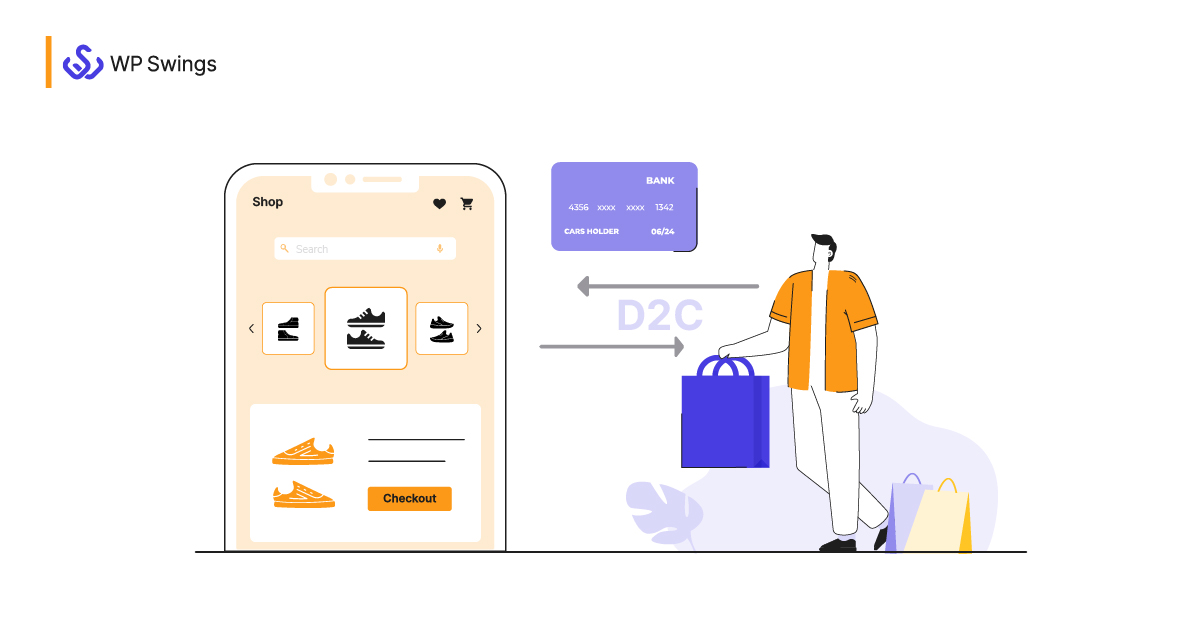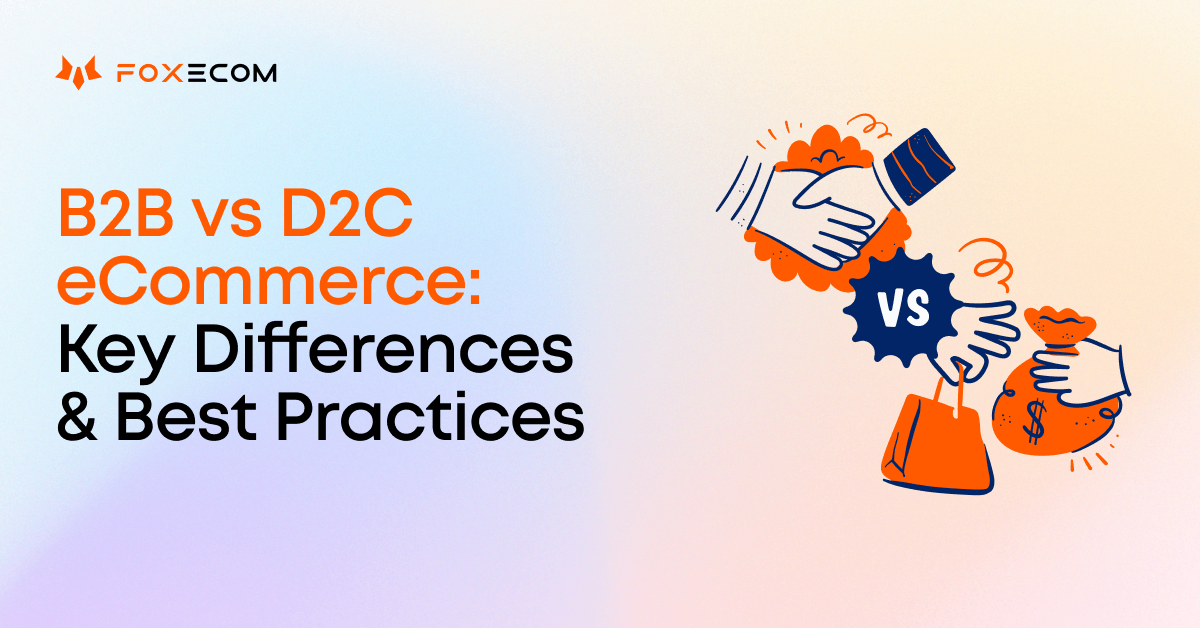Social Commerce and the D2C Ecommerce Agency: What You Should Know
Checking out the Prospective of D2C Ecommerce: A Comprehensive Guide for Companies
The D2C ecommerce model provides a significant change in exactly how brand names involve with customers. It makes it possible for business to bypass typical retail channels, fostering much deeper links and potentially enhanced revenue margins. This approach is not without its complexities. Comprehending the subtleties of D2C ecommerce is crucial for brands aiming to flourish. What methods can they adopt to browse this advancing landscape properly? The solutions may redefine their organization techniques.
Understanding the D2C Ecommerce Design

Key Benefits of D2C Ecommerce for Brands
The D2C ecommerce model supplies brand names considerable advantages, specifically concerning increased profit margins. By getting rid of middlemans, firms can retain a larger share of sales revenue. Furthermore, this direct connection with customers promotes enhanced brand name commitment, motivating repeat purchases and long-term engagement.
Raised Earnings Margins

Enhanced Brand Name Commitment
Structure on the economic advantages of D2C ecommerce, improved brand name commitment arises as one more crucial advantage for firms involving straight with consumers. By establishing a straight connection, brands can promote deeper connections with their clients, gaining understandings into preferences and actions. This straight communication enables for even more customized advertising and marketing strategies, which resonate strongly with consumers. In addition, brands have the possibility to regulate their messaging and consumer experience, strengthening brand values and developing depend on. When clients feel a personal link, they are most likely to return, support for the brand name, and join neighborhood interaction. Eventually, boosted brand name commitment not only drives repeat purchases however additionally grows an enthusiastic consumer base, more solidifying a brand's placement in the marketplace.
Obstacles Faced by D2C Brands
D2C brand names encounter numerous substantial challenges that can influence their success. Supply monitoring concerns can bring about equip shortages or excess, complicating procedures and client satisfaction. Furthermore, advertising and marketing budget restraints often limit the capability to efficiently involve and reach target audiences.
Stock Administration Issues
Efficient supply monitoring presents an awesome difficulty for several brands operating in the direct-to-consumer (D2C) space. These brands typically come to grips with varying need, which can lead to overstock or stockouts, eventually impacting customer complete satisfaction and revenue. In addition, the absence of innovative stock radar can lead to disparities between actual stock degrees and reported data, making complex order gratification. The diverse series of products D2C brands normally offer likewise complicates inventory management, as variations in sizes, shades, and styles require more thorough oversight. In addition, many D2C businesses may deal with minimal warehousing capacities, resulting in ineffective use of space and resources. As a result, efficient supply administration continues to be an important difficulty for D2C brands going for sustainable growth and functional performance.
Marketing Spending Plan Constraints
Steering advertising and marketing budget plan restrictions is a considerable challenge for lots of direct-to-consumer (D2C) brands. Restricted funds often restrict these companies' ability to purchase all-inclusive marketing strategies, leading to decreased presence in an affordable market. D2C brand names regularly come to grips with the need to take full advantage of roi (ROI) while targeting certain target markets effectively. This challenge is intensified by rising costs in digital advertising and marketing and the need to assign funds across numerous channels, including social networks, internet search engine, and email advertising. Numerous D2C brands need to introduce affordable advertising services, leveraging natural growth strategies and influencer collaborations. Eventually, effectively navigating these budget plan restrictions is important for sustaining development and accomplishing long-lasting profitability in the developing ecommerce landscape.
Methods for Building a Successful D2C Ecommerce Organization
As consumers increasingly look for direct connections with brand names, developing an effective D2C ecommerce service requires a calculated strategy that focuses on client interaction and depend on. One reliable strategy is to create engaging brand narratives that resonate with target audiences, cultivating emotional links. Using social media systems can enhance presence and assist in two-way interaction, enabling brand names to involve directly with customers.Moreover, individualized experiences with tailored advertising and marketing efforts can substantially improve customer retention and commitment. Applying commitment programs and offering unique bargains can even more incentivize repeat purchases.Streamlining the purchasing procedure is vital, guaranteeing a straightforward interface that enhances the shopping experience. Furthermore, clear communication regarding delivery and returns constructs trust fund and urges customer confidence.Finally, actively seeking client responses and responding to it shows a commitment to enhancement and customer fulfillment, critical elements in the competitive D2C landscape.
Leveraging Modern Technology for Enhanced Client Experience
In today's affordable D2C ecommerce landscape, modern technology plays a pivotal role fit consumer experiences. Organizations increasingly make use of sophisticated devices such as fabricated knowledge, chatbots, and customized formulas to boost interactions and improve the buying process. By incorporating these innovations, brands can offer customized item suggestions based upon private preferences and shopping habits, fostering an extra appealing experience.Moreover, receptive website layouts and mobile applications ensure that clients can access services flawlessly across various gadgets. Improved repayment solutions, including one-click check outs and digital purses, further simplify transactions, making it much easier for website customers to make purchases.Data analytics also makes it possible for businesses to gather understandings into consumer habits, enabling continuous enhancement of offerings and solutions. In general, leveraging technology not only improves consumer contentment yet additionally cultivates loyalty, ultimately driving lasting success in the D2C ecommerce industry.
Advertising Tactics to Drive D2C Sales
Just how can brands successfully catch the interest of customers in a saturated market? To prosper in the direct-to-consumer (D2C) landscape, brands should use targeted marketing techniques. Utilizing social media sites systems, brands can involve customers via interactive material, influencer collaborations, and user-generated messages. Customized email projects can additionally promote a sense of connection, supplying tailored promos based on customer habits and preferences.Moreover, narration plays a crucial duty in setting apart a brand's story, making it relatable and remarkable. Brands need to invest in seo (SEARCH ENGINE OPTIMIZATION) to improve visibility, ensuring their products are easily visible online. In addition, leveraging information analytics permits organizations to improve their advertising and marketing approaches and understand consumer trends better. Inevitably, a multi-channel method that integrates creativity with data-driven understandings can greatly boost D2C sales, allowing brand names to attract attention in a jampacked industry.
Future Fads in D2C Ecommerce
With the fast advancement of technology and customer choices, the future of D2C ecommerce is poised for significant improvement. Arising fads suggest a change towards hyper-personalization, where brands leverage information analytics to tailor offerings to private customer needs. This customization enhances consumer experiences, cultivating loyalty and engagement.Moreover, sustainability is ending up being a necessary factor, with consumers increasingly preferring brands that prioritize environmentally friendly methods - D2C Ecommerce Agency. Business are expected to take on clear supply chains and sustainable materials to fulfill this demand.The integration of expert system and enhanced truth will in addition reinvent the purchasing experience, enabling consumers to imagine products in their environments before purchase. Additionally, social commerce is expected to grow, as platforms like Instagram and TikTok assist in seamless buying experiences straight within social media.These fads collectively represent a dynamic future for D2C ecommerce, emphasizing customer-centric approaches and ingenious technologies that redefine customer interactions
Regularly Asked Concerns
What Industries Benefit The Majority Of From D2C Ecommerce?
The present concern highlights markets that thrive with direct-to-consumer (D2C) ecommerce. Extremely, style, beauty, electronic devices, and food sectors take advantage of D2C models to enhance brand name loyalty, boost consumer relationships, and optimize revenue margins successfully.
Just How Do Delivering Costs Influence D2C Pricing Techniques?
Delivering prices greatly affect D2C rates approaches. Companies must stabilize these costs with affordable rates, thinking about consumer assumptions and earnings margins. Reliable monitoring of delivery can boost customer complete satisfaction and drive sales in direct-to-consumer versions.
What Settlement Choices Should D2C Organizations Deal?
D2C organizations need to offer diverse payment options, including credit/debit cards, electronic budgets, and purchase now, pay later solutions. This range enhances client benefit, boosts conversion rates, and caters to different customer preferences in the on-line buying landscape.
Exactly How Can D2C Brands Deal With Client Returns Properly?
D2C brand names can manage consumer returns effectively by implementing straightforward return policies, offering prepaid shipping labels, and guaranteeing punctual reimbursements (D2C Ecommerce Agency). Clear communication and streamlined processes enhance client complete satisfaction and encourage repeat organization
What Lawful Factors To Consider Exist for D2C Ecommerce Procedures?
Lawful considerations for D2C ecommerce procedures consist of conformity with consumer defense laws, information privacy policies, copyright civil liberties, and taxes demands. Brand names have to navigate these complexities to prevent lawful challenges and guarantee smooth operations. By eliminating middlemans, D2C brand names can use competitive prices and cultivate an extra intimate partnership with their customers.The D2C design is characterized by its dependence on electronic systems, making it possible for brands to make use of social media, on-line markets, and their very own sites to involve with consumers directly. D2C ecommerce assists in the collection of useful customer data, enabling brand names to tailor their offerings and advertising and marketing techniques efficiently, inevitably driving sales and boosting margins. In addition, brand names have the opportunity to manage their messaging and consumer experience, strengthening brand values and building depend on. As consumers progressively look for straight links with brands, developing an effective D2C ecommerce service calls for a calculated method that focuses on client interaction and trust. D2C brands can manage customer returns properly by carrying out user-friendly return policies, offering prepaid shipping labels, and making sure prompt refunds.